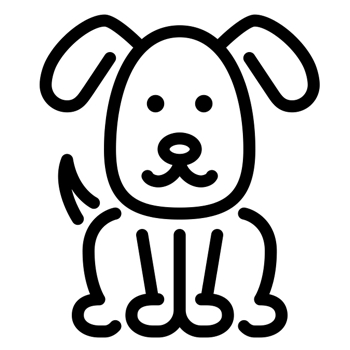Labbe

With two dog breeds as popular and well-loved as the Labrador Retriever and the Beagle, it was an inevitability that they would one day join forces to create a coveted ‘designer dog’. With the kind and tolerant personality of the Labrador and the happy, playful nature of the Beagle, the Labbe is a joy to be around. As they need lots of stimulation, both mental and physical, owners should be aware of the real time commitment involved and should ensure they are prepared for the dedication this dog demands.
Labbes tend to retain the narrower face and wider ears of the Beagle though have longer limbs and a body that is taller. Their coat may be tri-colour like its Beagle parent but could just as easily be brown, black or yellow.
About & History
A mixed breed of many names, the Labrador Retriever cross Beagle may be called the Labbe, Beagador, Labeagle or even Labbe Retriever. This ‘designer dog’ likely originated in the States sometime in the 1990s. Though the history of the Labbe is limited, we can certainly look to the past of its two parent breeds to get a better idea of where it came from.
The Labrador Retriever
Despite its name, the Labrador Retriever does not originate from Labrador and is actually believed to come from Newfoundland. Most agree that its ancestor is the St. John’s Water Dog, which is an extinct breed that was native to Newfoundland and was anecdotally more at home in the water than on land. Historically, the Labrador was used to hunt on both dry and wet land, making it a firm favourite of the local fishermen.
Of course, many still use the Labrador for this purpose today, though the breed has branched out into a multitude of other disciplines. Labradors may be seen as therapy dogs, guide dogs to the blind and even as drug detectors in airports and ferry terminals. In fact, the Labrador is such a successful breed that it is included in the ‘Top Ten List of Popular Dogs’ in a large number of countries all over the world today.
The Beagle
The Beagle is also a scenting hound and would traditionally work in large packs, hunting rabbits and hare. Some experts believe that the Beagle comes from an ancient line of smaller dogs that could be found in Greece during the 5th century, though this is hard to prove. The charming looks of the Beagle have contributed to its modern-day success and a Beagle even won best in show in the Hound group in Crufts in 2008.
Appearance
The Labbe most commonly exhibits a head that resembles the Beagle and a body that is somewhat larger and stockier, like that of the Labrador Retriever. However, this is not a fixed rule and a first-generation cross may resemble either parent more. Most are built in good proportion with limbs that are parallel and a well-muscled body.
Most individuals will have a long muzzle and relatively loose jowls. Their eyes are dark brown and gentle, though not overly large. Their black nose contains wide-open nostrils and sits proudly at the front of their face. Their ears sit snugly against their head and are typically wider and longer than those of the Labrador. Their tail is long and of medium thickness, sometimes with a kink at the end.
Once mature, the Labbe usually measures from about 48cm to 56cm, weighing between 11kg and 18kg. The fur of the Labbe is short and smooth and may be a multitude of colours, including brown, black, tan, yellow and red. Many dogs are bi-coloured or tri-coloured.
Character & Temperament
This fun-loving mixed breed has a real zest for life and wants everyone to know about it! They have seemingly endless amounts of energy and are not easily discouraged. A sweet-natured soul, the Labbe loves to be in the company of both people and animals and makes friends wherever it goes. While their loyalty to their family is an asset, it can make them over-attached. If left by themselves for long periods of time, some Labbes can become unruly and destructive due to boredom and anxiety.
With their hunting instincts still strongly remaining, the Labbe cannot be trusted with small pets, such as gerbils or guinea pigs. Equally, caution must be exercised when in public places as a Labbe who gets the scent of something will not be easy to call back.
Some Labbes are known as ‘eternal puppies’ still acting like six months old at the age of eight or nine. For those looking for a calm and relaxed dog, they should probably look elsewhere as these dogs never seem to slow down.
Trainability
Training a Labbe can pose several challenges but is ultimately very rewarding. Their curiosity and intelligence make them a willing participant in training tasks, but they can have a short attention span and are easily distracted. They live to please their owner so always aim to do well but sometimes find it hard to stay motivated. For most, using food as a reward provides the best results.
It is absolutely essential to start the training of a Labbe from a young age, so they can understand their role within the home and any boundaries that have been put in place. Impishness and hyperactivity can become issues when rules are not established from puppyhood.
Health
As with any dog, the Labbe is disposed to a number of health conditions. It is typically true that mixed breeds are healthier than pure-breeds so we would generally expect to see less issues in the Labbe than in its parents.
Ear Infections
One of the real tragedies when it comes to the beautiful ears of the Labbe is that they are so very prone to developing ear infections. Though owners can try to minimise the risk by closely monitoring ears, drying them after they get wet and using ear cleaners regularly, some dogs go on to develop chronic ear infections regardless.
Hip and Elbow Dysplasia
Hips and elbows that do not form as they should are said to be dysplastic. Joint health can be assessed by a veterinarian in a conscious animal, though often a sedation or anaesthetic is required to better assess the joints and to take images, such as X-rays or CT scans.
Animals that are mildly affected may be managed with joint supplements, weight restriction and exercise plans while those with severe forms of the disease may need life-long medication and even surgeries.
Epilepsy
When a dog has a seizure, it may or may not have epilepsy. Epilepsy is a term used to describe seizure activity that happens for no known reason. For example, a dog with low blood sugar may have a seizure but is not epileptic.
To determine if a dog has got epilepsy, several tests need to be carried out to check for any other underlying issues. Most will have urine tests, blood tests and imaging of the brain. For some, medication will be prescribed to help to prevent and control their seizures long-term.
Hypothyroidism
Some middle-aged to older dogs will suffer from a lack of thyroid hormone and a condition known as hypothyroidism. Signs can be subtle and are often missed in the early stages. Lethargy, weight gain, chronic skin issues and a slow heart rate are all characteristic of this endocrine disease.
Changes, such as a low thyroid hormone level, a mild anaemia and a raised cholesterol may be seen on bloodwork. Affected animals typically respond well to medication, which usually consists of a daily tablet.
Exercise and Activity Levels
Do not underestimate the activity requirements of the Labbe and their impressive ability to just keep on going. Seemingly never satisfied, the Labbe will happily go for an hour walk, lie down for five minutes and then get back up, ready to go again. As well as going for walks, they love to participate in agility, tracking, hunting and ball games.
Made for the water, the Labbe will jump at any opportunity to go for a paddle or swim, whatever the weather. Their ideal home would be in a rural location with forests and streams nearby, as they relish time spent in the great outdoors.
Grooming
Brush the thick, short coat of the Labbe once or twice a week to help spread the natural oils and to remove any dead fur or dander. Claws that become long or thick should be trimmed about every four to six weeks, though many active dogs will keep their claws short themselves. Clean out any ear wax once a week and monitor the pendulous ears of the Labbe for signs of infection on a daily basis.

